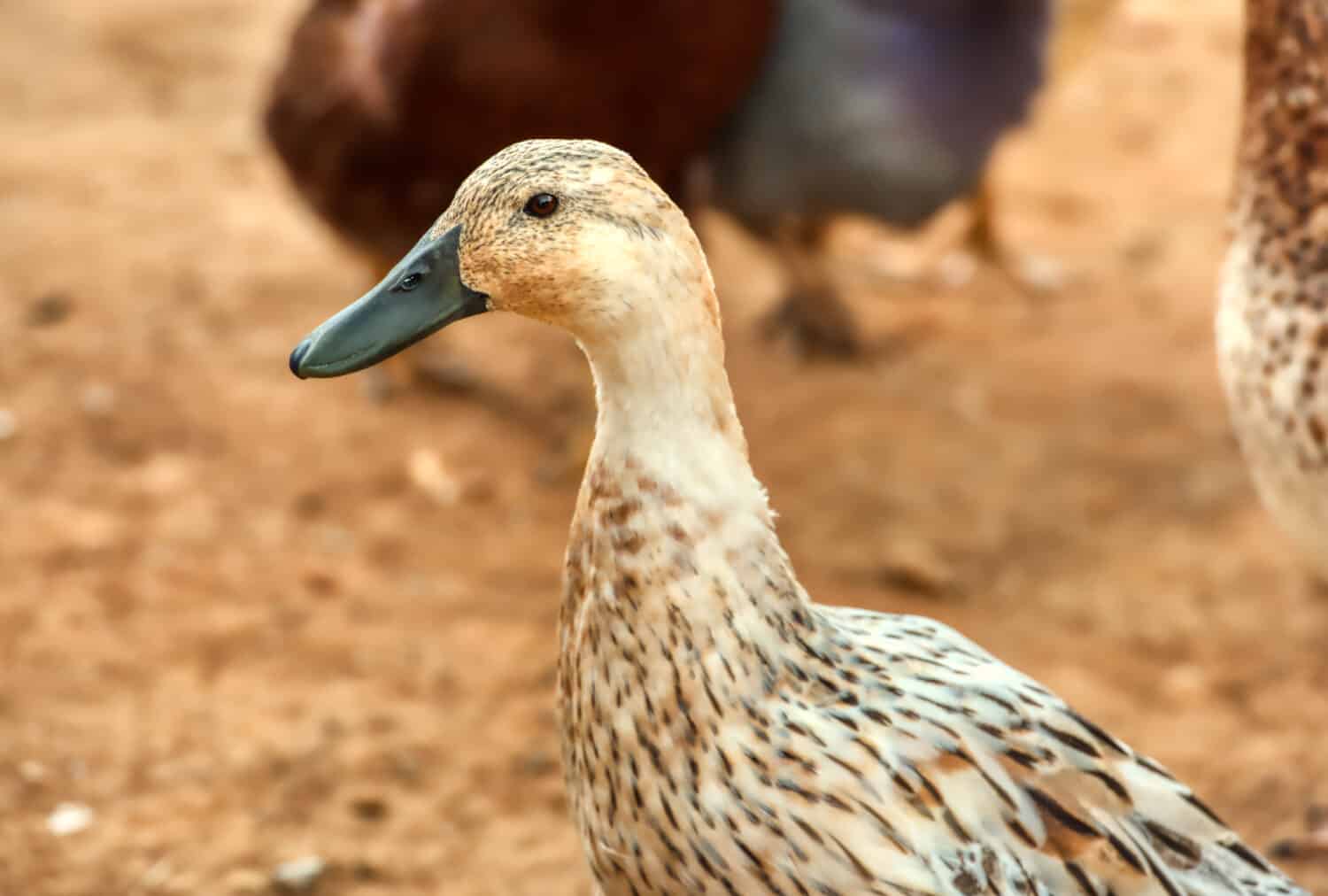Quack, quack! If this sounds like music to your ears and you want to add a fluffy animal friend to your family, you might want to consider getting a duck for a pet. Not only are they adorable as ducklings, but these birds can grow up as part of your family and develop strong bonds. If you handle them from a young age, they will become quickly accustomed to people.
There are a few considerations when deciding to get a pet duck, however. Most of these are essential for their health and well-being, as well as the health of their environment (your home). If you are looking for a pet that doesn’t require much to get started, ducks may not be the best option for you. Fortunately, we’ve compiled a list of the essentials that you need to purchase and raise a duck so that you can get a realistic idea of the time, space, and financial commitment needed to bring one of these birds into your life. We’ve also thrown in a few nice-to-have items that can make life with your new feathered family member much more enjoyable and fun.
Buying a Duck
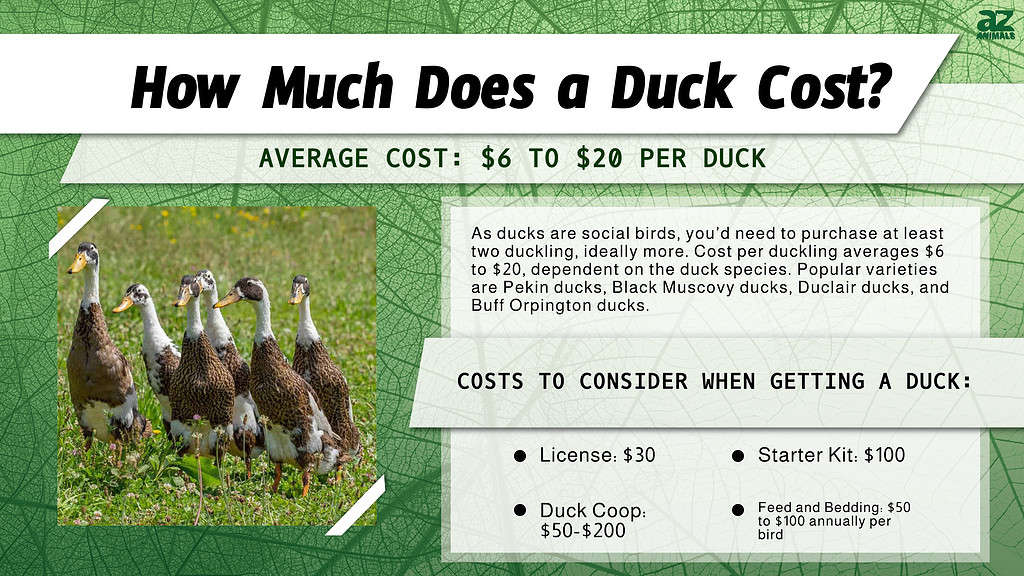
One of the first things you should consider is the actual purchase cost of the bird itself. There are a few different species and varieties of ducks, each with its own costs and considerations. It’s important to note that ducks are social birds and need a flock to do well. Most places will expect you to buy at least two ducklings, ideally more, to create a flock in your home.
$6 to $10
Cayuga ducks are on the upper end of this range but make excellent pets. When you purchase just a few, expect to pay around $10 per bird. Buying more can lower the price per animal. Black Swedish Ducks are another breed that costs around $9 per duck, which is lowered to around $6 per bird when you buy 30 or more ducklings. Popular Welsh Harlequin Ducks cost between $11 and $18 each when purchased in groups of fewer than 30.
$11 to $15
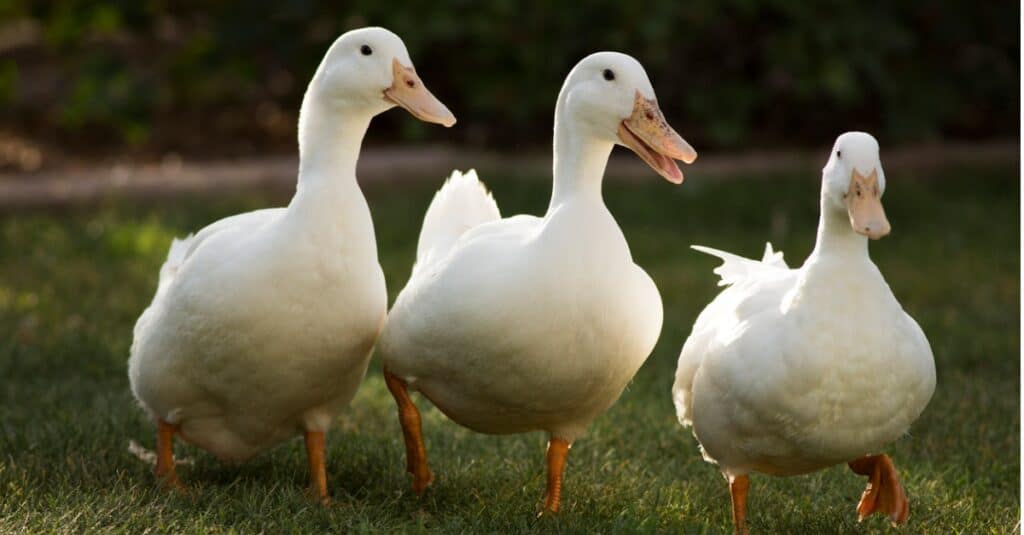
American Pekin ducks have all-white plumage.
©iStock.com/Maria Jeffs
Buff Ducklings are adorable and fun to keep as pets. They are often around $11 per unsexed duckling. If you specifically want a female, expect to pay up to $2 more per duck. Some breeds have an even steeper increase for female birds. Like with other breeds, the more ducklings you buy, the lower the cost per animal. Of course, you need to keep in mind that you’ll have to house and care for a larger flock, which adds to the overall cost in other areas.
Runner ducks come in a variety of colors, including blue, black, and chocolate. They typically cost around $12 to $15 per duckling. These animals are popular to keep on the farm. Pekin ducks cost slightly less, usually closer to $11 to $12 each.
$16 to $20
Black Muscovy Ducks are one of the more expensive options, often costing around $20 per duck if you buy just a few. The costs can be reduced by as much as $5 per animal once you purchase a flock of 30 or more. Duclair ducks are raised for their meat and cost up to $18 per female duck. Males are much less expensive, often closer to $9 per duckling.
Factors Affecting Duck Prices
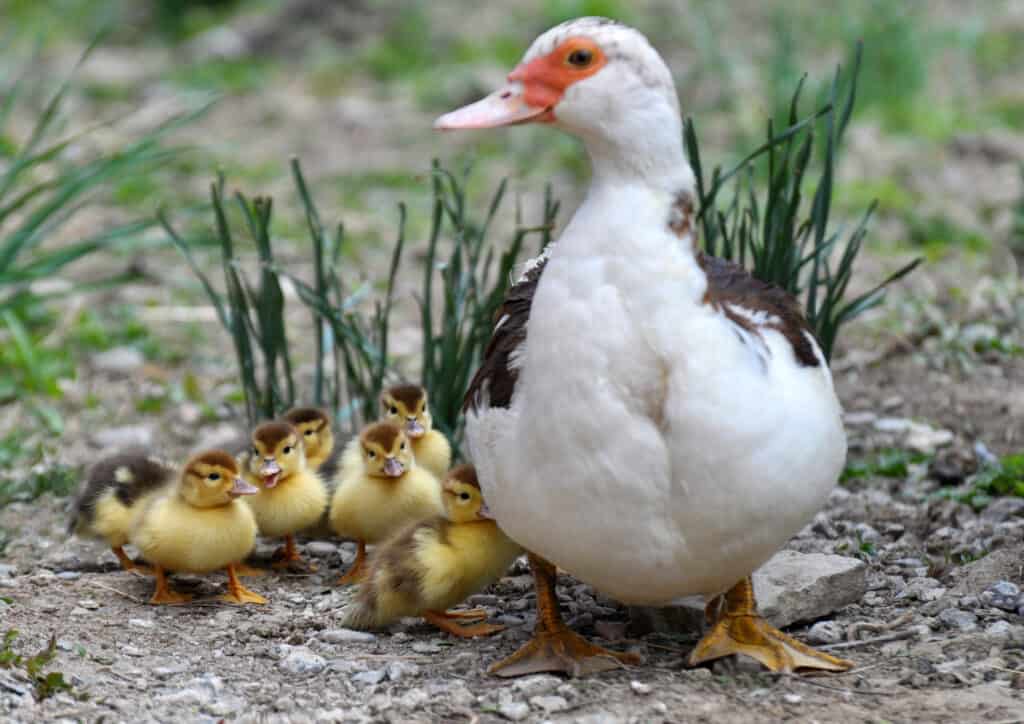
Female Muscovy ducks take most of the responsibility for caring for and protecting their ducklings.
©iStock.com/Orest Lyzhechka
Breed and age are the two biggest factors that impact duck prices. Some breeds are more expensive than others. Older ducks tend to be a bit pricier than ducklings, mostly because they are more likely to survive. Very old ducks are the exception, of course. Not many people want to buy elderly ducks so they are not very expensive or even readily available to purchase. You might be able to rescue or adopt an elderly duck, although it can be difficult for them to adjust to a new environment.
Sex and purpose are two other factors that can impact duck prices. Female ducklings are almost always more expensive than males. This is because females can lay eggs, which you can eat or sell. The addition of a male duck in the flock can also result in fertilization and raising another generation of ducks. If you want to breed ducks, having more females results in a larger flock. You can also buy ducklings unsexed. This means that you get the duckling without knowing whether it is a boy (drake) or girl (hen). This is also referred to as purchasing the ducklings straight-run.
Finally, where you purchase your ducks matters. Farm stores tend to get a lot of ducklings in at once and can offer slightly cheaper prices. Hatcheries can be more expensive but most offer breeds that are hard to find in mainstream stores. In most cases, reputable places to buy ducks will want you to purchase more than one. This is because ducks need companionship from other ducks, their flock, in order to do well.
Purchase Considerations
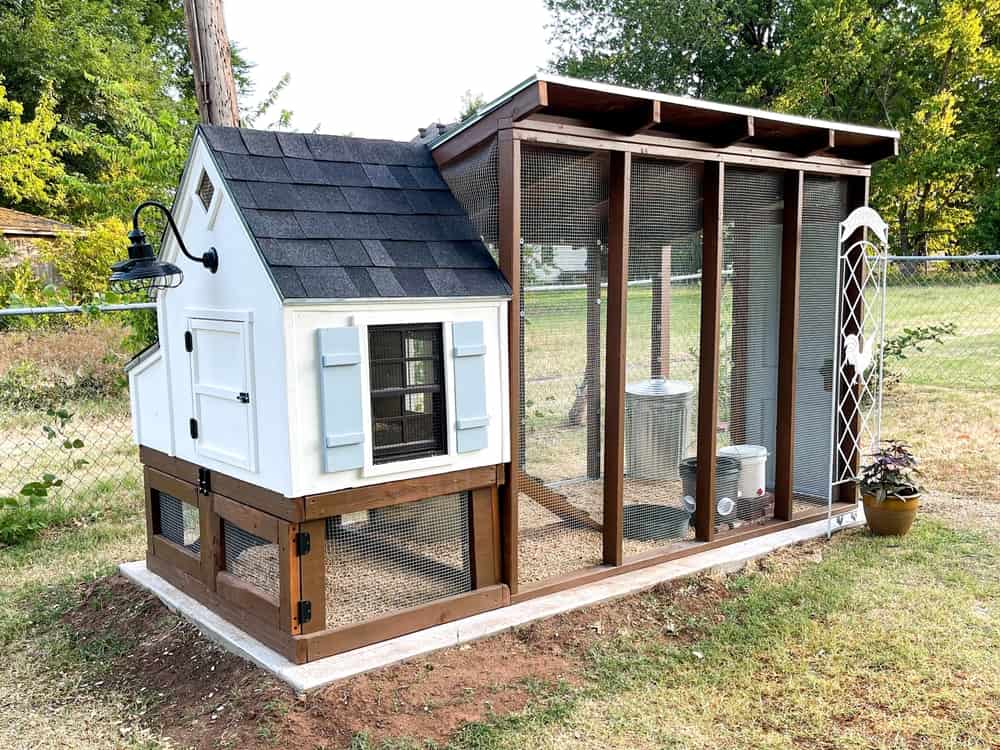
You’ll need plenty of space to keep your ducks healthy and many places require a certain amount of square footage per bird.
©Courtney Jenckes/Shutterstock.com
One factor that can be overlooked is the legal requirements related to owning a duck or other poultry. Some areas prohibit pets like ducks, classifying them as farm animals rather than pets. This might add some limitations to where they can be housed. Some states also require permits or licenses, which are typically around $30. Each state and municipality sets its own regulations, however, so costs and requirements vary.
Some breeds need more space than others, an additional thing to think about when deciding on the best breed for your home. If you have limited space, you might need to opt for a smaller duck or one that does better in small areas. Just like permits and licenses, housing requirements can vary by location. Make sure to check with your local regulations. One of the most common requirements is square footage in order to keep these animals on your property. If you have less space, you might need to get special permission.
If you aren’t sure how to interpret the local regulations or just want advice on how to be a good, responsible duck parent, look for local groups to join. These are often made up of experienced owners who can make recommendations to keep you and your new pet happy.
Supplies and Feeding
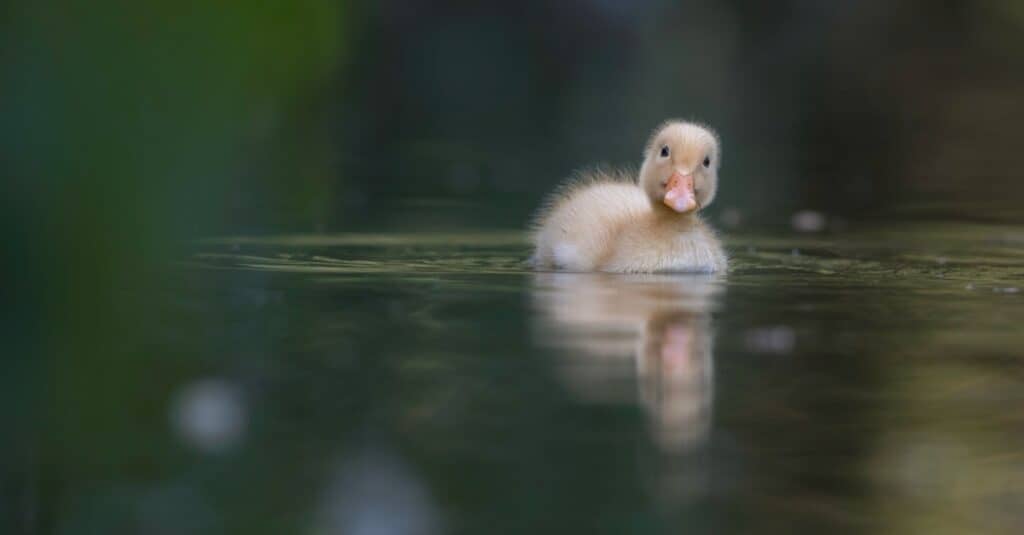
Ducklings like to explore water, so you may want to add a small pool to their environment once they get big enough.
©iStock.com/Nick Hurst
When you get your baby ducklings, you’ll have to set up a special environment for them called a brooder. In some cases, you can purchase a starter kit with your ducklings that includes everything you need. These kits, which you can find for around $100, come with a small enclosure made for ducklings, a heat lamp, and a way to attach everything. Some include bedding or a brooder plate, which adds around $25 to $50 to the cost. You can DIY a decent brooder by using a big plastic tote and adding the other features. You’ll also need a feeder and water reservoir.
As they get bigger, you can move the ducklings from their brooder to a larger coop. The main function of the brooder is to help them stay warm under the heat lamp or by using a brooder plate. This is essential until they are old enough to regulate their temperature on their own. Once they can do that, they are ready to graduate to the coop.
Creating a Duck Coop and Run

Ducks can use the same type of coop structures as chickens, although they also like water features such as ponds or small pools.
©Cynthia Farmer/Shutterstock.com
As they grow, ducks need plenty of open space in their environment, which is often one of the most limiting and expensive factors when budgeting for a pet duck. Some municipalities only allow ducks on larger properties. If you have enough space, the next thing you have to budget for is the right home for your duck. Like other birds, ducks cannot control their bowel movements. Duck poop is particularly smelly, so you’ll need to be able to keep them outside.
The best duck habitats include a coop and an enclosed run. In fact, some places even require these before issuing a permit or license. You can build your own coop or purchase a ready-made structure. DIY coops often cost between $50 and $100, although costs vary depending on what you have available. Commercial coops can be around $150 to $200, with the high-end or large models costing in the thousands. At a minimum, you should have four square feet of floor space for each bird inside the coop. Providing more space is even better. Ducks also need plenty of outdoor space. Allow 16 square feet of floor space outside of the coop for each of them. This should be enclosed to protect them from potential predators.
A pond is a nice addition to the duck’s environment but is not usually required for permits or licenses. Experienced duck owners will likely tell you how much happier their birds are, however, when they have access to a pond. You can set up an elaborate pond as part of your landscaping for you and your pets to enjoy, which may cost hundreds of dollars or more. You can also set up a few hard-sided kiddie pools for them to swim and splash in, which is significantly less expensive. If you live in a really cold climate, you might need to add ways to control the temperature in the coop, run, or pond to make sure it remains accessible all year.
Ongoing Costs of Having a Duck
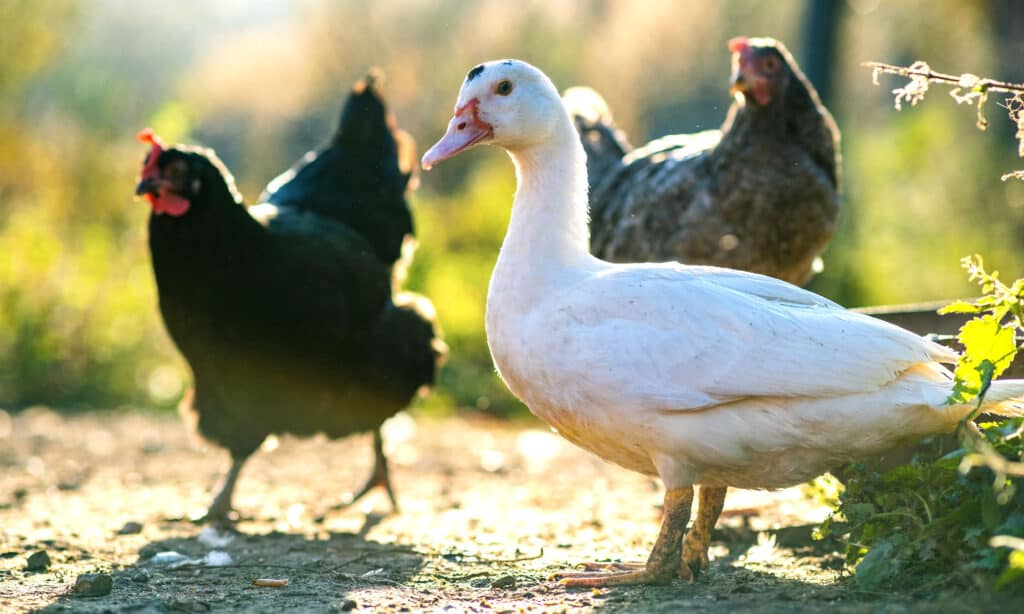
When allowed to free range, ducks forage on seeds and bugs.
©Bilanol/Shutterstock.com
Like with any pet, you’ll need to provide your duck with the appropriate food and water. Baby ducklings have specialized nutritional needs and should eat duckling feed. Once they mature, you can switch to adult feed. Ducks typically eat a few pounds of food each week, although some are good at foraging as well. If you want to save money, purchase food in bulk bags.
You’ll also have to periodically replace the bedding inside the coop. Pine shavings and hay both make good bedding for ducks and chickens. These materials are also relatively inexpensive and easy to find at farm stores. Ongoing costs of feed and bedding range from $50 to $100 annually for each bird in your flock. While vet visits can add to this cost, ducks don’t require annual exams or vaccines in most cases. As long as your pet is healthy and not injured, vet bills likely won’t play a large role in your duck budget.
Thank you for reading! Have some feedback for us? Contact the AZ Animals editorial team.

